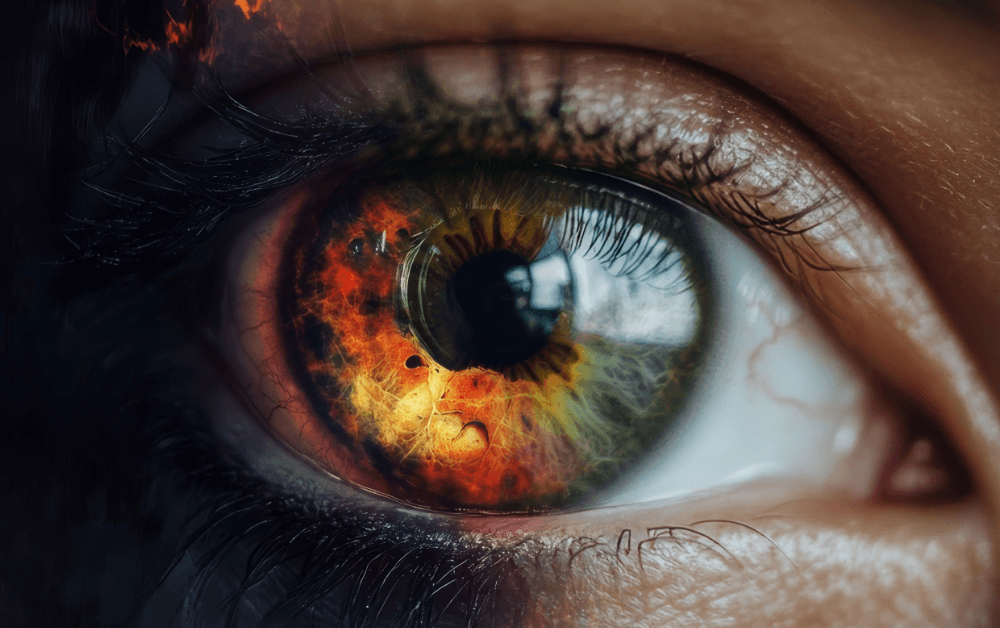Dr. Farhan Irshad shares tales, techniques and therapies for corneal repair and regeneration
Corneal trauma is one of the most common eye injuries, and its effects can be devastating, sometimes leaving permanent scars that cloud not only the patient’s eye but also their self-esteem. With modern treatments and innovative regenerative therapies, we’re now better equipped to heal these injuries. However, the journey from trauma to complete recovery is far from over.
Eye trauma accounts for approximately 3% of all emergency department visits, with corneal injuries representing the majority of these cases. The impact of such trauma can range from minor abrasions to severe injuries that threaten vision.
Traumatic incidents, often resulting from foreign bodies or abrasions, and exposure-related injuries, including chemical and thermal burns, can lead to long-lasting consequences. Each injury presents its own challenges, demanding immediate and appropriate responses to mitigate long-term damage.1
Dr. Farhan Irshad—a cornea specialist at the Eye Clinic of Austin in Texas, USA—shares healing mechanisms, explores current treatment options and highlights the latest developments in preserving the cornea.
More than meets the eye
Corneal trauma can take many forms, each leaving its mark on the eye’s fragile architecture. From the sharp edge of a foreign body to the searing pain of chemical burns, corneal injuries disrupt not only its structural integrity but also its vital functions.
Common sources of corneal abrasion include everyday activities, such as woodworking or metal grinding, where high-speed projectiles can easily penetrate the eye. “For the majority of our patients… I would say it’s foreign bodies,” noted Dr. Irshad. More severe injuries, like lacerations or perforations, often result from accidents involving power tools, with the nature of the projectile significantly influencing the damage.
The consequences of such injuries extend beyond physical harm, casting a shadow over one’s vision. Scarring from corneal trauma can impair light refraction, leading to diminished visual acuity and challenges in depth perception, which can dramatically alter a person’s daily life and career.
For instance, a 23-year-old patient came to Dr. Irshad with a deep corneal injury after a fish hook became embedded in his eye. This incident not only jeopardized his vision but also raised concerns about his ability to pursue his passions and livelihood.
The psychological impact of corneal injuries is profound and often overlooked. Beyond the physical pain and the potential for permanent vision loss, individuals may grapple with issues of self-esteem and body image, particularly when scarring affects the appearance of their eyes. “The scarring can affect cosmesis, which in turn affects someone’s self-esteem and appearance,” Dr. Irshad pointed out.
These challenges can lead to feelings of depression and anxiety, significantly affecting one’s quality of life. Recovery, therefore, must encompass more than just physical healing. It requires a holistic approach that addresses the emotional and psychological ramifications of living with the aftermath of corneal trauma.
Of natural healing and medical intervention
When a corneal abrasion occurs, limbal stem cells play a crucial role, migrating to cover the defect with a single layer of epithelial cells. This process, however, is influenced by the size, depth and location of the injury.
“The depth of involvement of the traumatic injury, the severity of the penetration, the size of the corneal defect, and the location—whether central or peripheral—can certainly affect the outcome,” explained Dr. Irshad. An injury to the central cornea can have far more detrimental effects on vision compared to one located at the periphery.1
For minor injuries, the corneal epithelium can regenerate relatively quickly, often within 24 to 48 hours. However, larger defects require a more complex response, as cells ‘slide’ over the wound, and the basal layer must proliferate to restore normal thickness—a process that can take up to six weeks.2
The cornea’s unique structure, particularly its avascular nature, poses a challenge to this healing process. “The cornea never really fully heals,” emphasized Dr. Irshad, highlighting the limitations of its regeneration capabilities.
Moreover, the presence of infections can severely hinder healing. A wound contaminated by a foreign body, such as a piece of glass, may complicate the recovery process, leading to prolonged healing and increased risk of scarring. “Infections that result from trauma would obviously adversely affect outcomes,” Dr. Irshad explained.
Understanding the complexity of the corneal healing process highlights the importance of timely medical intervention and the potential need for surgical support in cases of severe trauma. With breakthroughs in medical science, we are better equipped to aid the cornea’s recovery. However, the journey from trauma to regeneration remains a delicate balance of nature’s healing mechanisms and medical expertise.
A multifaceted strategy for complex cases
Treating corneal surface injuries has evolved to prioritize both healing and the prevention of further complications. The natural recovery process can be supported by treatments like antibiotics to prevent infection and medications for pain management, such as cycloplegic agents, which help to alleviate discomfort by relaxing the eye muscles.1
In more complex cases, however, treatment becomes multifaceted. For instance, corneal foreign bodies— like the fish hook case treated by Dr. Irshad—require immediate and careful removal to avoid long-term damage. “We ultimately removed the fish hook in the operating room and sutured the laceration closed,” he recalled.
The initial treatment included antibiotics to prevent infection, but despite this early intervention, deeper issues can arise. “Scarring was fairly deep into the stromal tissue… in the visual axis, causing irregular astigmatism and preventing him from being able to see,” explained Dr. Irshad.
This patient—left nearly legally blind—eventually required a corneal transplant to restore vision. The deep anterior lamellar keratoplasty (DALK) procedure saved the young man’s eyesight.
Beyond these interventions, treatments such as amniotic membrane grafting and high doses of vitamin C are also utilized to enhance healing. According to Dr. Irshad, amniotic membrane grafting promotes rapid wound healing and provides a favorable environment for recovery, and vitamin C helps prompt collagen healing of the cornea.
While these treatments can be highly effective in halting further damage and promoting healing, they come with limitations. Suturing, for example, can save the eye, but carries risks of complications and involves operating room time. Amniotic membrane grafting can be costly and may not always be covered by insurance— making access a daunting hurdle for many patients. And despite rapid intervention, complications such as scarring, limbal stem cell deficiency, or even secondary glaucoma can arise.1
Even with advances in corneal repair techniques, visual prognosis remains uncertain, particularly in cases involving deeper tissue damage. “Just because you repair someone’s cornea doesn’t mean they will regain their vision,” explained Dr. Irshad.
His fish hook patient’s vision improved to 20/60 post-DALK. Subsequent contact lens fitting brought it even closer to 20/30, showcasing the potential for recovery despite the initial severity of the injury. However, despite this significant improvement, the patient’s vision remains slightly below average. While 20/30 vision is typically sufficient for most daily activities, it may still pose challenges for tasks requiring sharp, precise vision, such as reading small print or detailed work.
Moreover, traditional treatments like corneal transplants, though lifechanging, face challenges of donor shortages, the risks of rejection and prolonged recovery times. As the demand for corneal transplants far outweighs the availability of donor tissues globally, new approaches such as tissue engineering and regenerative therapies are being explored to address these limitations.
Promising therapies and techniques
Emerging therapies and innovative techniques are sparking hope for more effective corneal surface repair treatments. At the forefront is stem cell therapy, a beacon for patients facing severe corneal epithelial injuries.
Stem cells, with their remarkable ability to self-renew and differentiate, are being harnessed to regenerate corneal epithelium. The integration of biological scaffolds—like amniotic membranes and hydrogels—provides the ideal environment for these cells to thrive. While these approaches show promise, they face challenges, particularly in retaining stem cells at the injury site, a hurdle that researchers are actively working to overcome.3
Tissue engineering has also made strides, with new scaffolds designed to improve stem cell retention and mimic the natural extracellular matrix of the cornea. The progression has evolved from simple two-dimensional structures to more complex, customizable designs, such as 3D-printed hydrogels. This advancement allows for a more tailored approach to repair, enhancing the potential for successful outcomes in corneal injuries.3
On the surgical front, keratoprosthesis offers a viable alternative for patients with recurring transplant failures. While this artificial cornea can be a lifesaver, it comes with a hefty price tag, often reserved for those who have exhausted other options.
“It’s much more expensive than suitable donor tissue,” Dr. Irshad shared. “We typically use an artificial cornea when someone’s failed a regular corneal transplant three times,” he added, illustrating the challenge of balancing cost and accessibility in treatment options.
Redefining possibilities for patients
As we stand on the brink of groundbreaking advancements in corneal repair and regeneration, it’s clear that the journey from trauma to recovery is one of remarkable complexity and perseverance. Corneal injuries, once feared for their potential to leave lasting scars are now met with a range of treatments that blend the ingenuity of modern medicine with the body’s natural healing processes.
Yet, as Dr. Irshad and his patient’s story reveal, even the most advanced therapies do not guarantee full restoration. The cornea, though resilient, bears the weight of each trauma, and healing is rarely straightforward.
What remains hopeful, however, is the progress being made in regenerative therapies and innovative surgical techniques. Stem cell research, tissue engineering and keratoprosthesis are no longer distant dreams—they represent tangible solutions that are slowly reshaping the future of ophthalmology.
With each new clinical trial and success story, we move closer to a time when corneal injuries, no matter the severity, can be treated with greater certainty and improved outcomes.
This progress comes with its own set of challenges. Accessibility, affordability and the intricate balance of patient care must all be considered as we forge ahead. The work is far from over, but with each step, the window of hope opens wider, offering patients the chance not just to recover their vision but to reclaim their lives.
References
- Willmann D, Fu L & Melanson SW. Corneal Injury. StatPearls Publishing, Treasure Island. July 17, 2023. Available at: https://www.ncbi.nlm.nih.gov/books/NBK459283/. Accessed on: October 1, 2024.
- Barrientez B, Nicholas SE, Whelchel A, et al. Corneal injury: Clinical and molecular aspects. Exp Eye Res. 2019;186:107709.
- Wang M, Li Y, Wang H, et al. Corneal regeneration strategies: From stem cell therapy to tissue engineered stem cell scaffolds. Biomed Pharmacother. 2023;165:115206.
Editor’s Note: A version of this article was first published in CAKE Magazine Issue 24.




